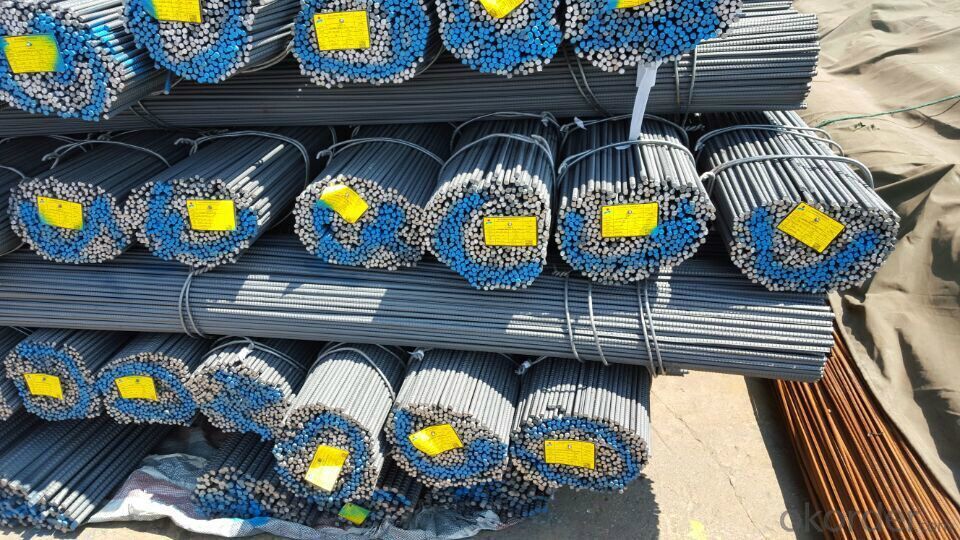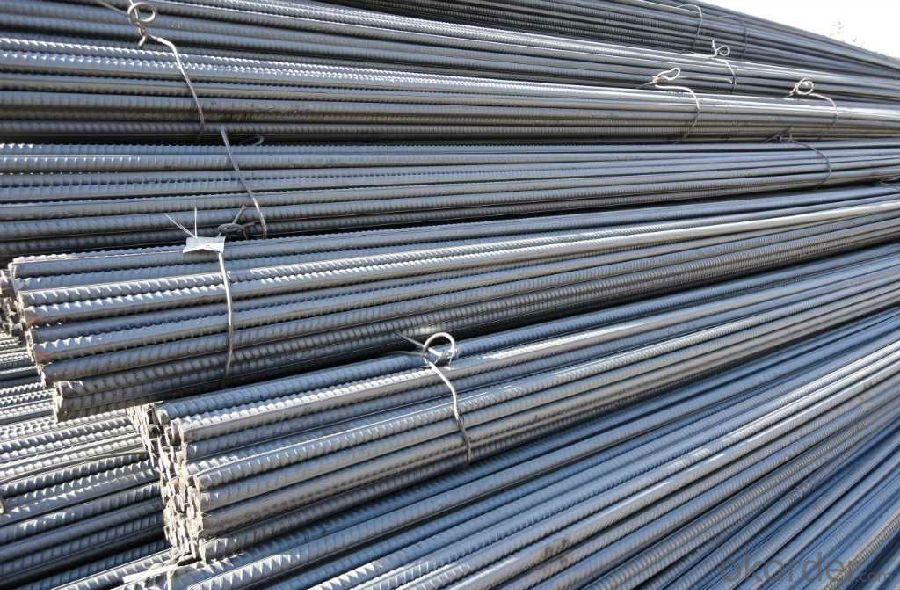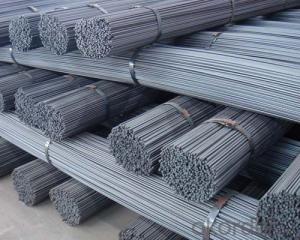Reinforcing Deformed Steel Bars with Grade HRB400-HRB500
- Loading Port:
- Tianjin
- Payment Terms:
- TT OR LC
- Min Order Qty:
- 25 m.t.
- Supply Capability:
- 20000 m.t./month
OKorder Service Pledge
OKorder Financial Service
You Might Also Like
Item specifice
OKorder is offering high quality Hot Rolled Rebars at great prices with worldwide shipping. Our supplier is a world-class manufacturer of steel, with our products utilized the world over. OKorder annually supplies products to Africa, North American and Asian markets. We provide quotations within 24 hours of receiving an inquiry and guarantee competitive prices.
Product Applications:
Deformed bar is widely used in buildings, bridges, roads and other engineering construction. Big to highways, railways, bridges, culverts, tunnels, public facilities such as flood control, dam, small to housing construction, beam, column, wall and the foundation of the plate, deformed bar is an integral structure material. With the development of world economy and the vigorous development of infrastructure construction, real estate, the demand for deformed bar will be larger and larger.
Product Advantages:
OKorder's Hot Rolled Rebars are durable, strong, and resist corrosion.
Main Product Features:
· Premium quality
· Prompt delivery & seaworthy packing (30 days after receiving deposit)
· Corrosion resistance
· Can be recycled and reused
· Mill test certification
· Professional Service
· Competitive pricing
Product Specifications:
Manufacture: Hot rolled
Grade: HRB400 – HRB500
Certificates: ISO, SGS, BV, CIQ
Length: 6m – 12m, as per customer request
Packaging: Export packing, nude packing, bundled
Grade | Technical data of the original chemical composition (%) | ||||||
C | Mn | Si | S | P | V | ||
HRB400 | ≤0.25 | ≤1.60 | ≤0.80 | ≤0.045 | ≤0.045 | 0.04-0.12 | |
Physical capability | |||||||
Yield Strength (N/cm²) | Tensile Strength (N/cm²) | Elongation (%) | |||||
≥400 | ≥570 | ≥14 | |||||
Theoretical weight and section area of each diameter as below for your information:
Diameter(mm) | Section area (mm²) | Mass(kg/m) | Weight of 12m bar(kg) |
6 | 28.27 | 0.222 | 2.664 |
8 | 50.27 | 0.395 | 4.74 |
10 | 78.54 | 0.617 | 7.404 |
12 | 113.1 | 0.888 | 10.656 |
14 | 153.9 | 1.21 | 14.52 |
16 | 201.1 | 1.58 | 18.96 |
18 | 254.5 | 2.00 | 24 |
20 | 314.2 | 2.47 | 29.64 |
22 | 380.1 | 2.98 | 35.76 |
25 | 490.9 | 3.85 | 46.2 |
28 | 615.8 | 4.83 | 57.96 |
32 | 804.2 | 6.31 | 75.72 |
36 | 1018 | 7.99 | 98.88 |
40 | 1257 | 9.87 | 118.44 |
50 | 1964 | 15.42 | 185.04 |
FAQ:
Q1: Why buy Materials & Equipment from OKorder.com?
A1: All products offered by OKorder.com are carefully selected from China's most reliable manufacturing enterprises. Through its ISO certifications, OKorder.com adheres to the highest standards and a commitment to supply chain safety and customer satisfaction.
Q2: How do we guarantee the quality of our products?
A2: We have established an advanced quality management system which conducts strict quality tests at every step, from raw materials to the final product. At the same time, we provide extensive follow-up service assurances as required.
Q3: Can you offer the third part inspection certificates ?
A3: Yes, we can apply third part inspection before shipping, such as SGS, BV, etc .
Images


- Q:What is the difference between steel rebars and FRP rebars?
- Steel rebars and FRP rebars are two different materials used for reinforcement in construction projects. The main difference between steel rebars and FRP (Fiber Reinforced Polymer) rebars lies in their composition and mechanical properties. Steel rebars are made of carbon steel and are known for their high tensile strength and durability. They have been widely used in construction for many years and are a reliable choice for reinforcing concrete structures. On the other hand, FRP rebars are made of fibers, such as glass or carbon, embedded in a polymer matrix. This composite material offers several advantages over steel rebars. Firstly, FRP rebars are lighter in weight, making them easier to handle and transport. This can reduce labor and equipment costs during construction. Secondly, FRP rebars are non-corrosive, unlike steel rebars. Steel rebars are prone to corrosion when exposed to moisture and chemicals, which can weaken the structure over time. FRP rebars do not rust or corrode, making them ideal for environments with high humidity, saltwater, or chemical exposure. Another significant difference is that FRP rebars have a high resistance to electromagnetic fields. This makes them suitable for applications in sensitive areas, such as hospitals, power plants, or telecommunication facilities, where electromagnetic interference should be minimized. However, there are also some limitations to consider with FRP rebars. They have lower tensile strength compared to steel rebars, which means they may not be suitable for heavy-load-bearing structures. Additionally, FRP rebars have a higher initial cost compared to steel rebars, although this can be offset by their long-term durability and reduced maintenance requirements. In summary, the main differences between steel rebars and FRP rebars lie in their composition, mechanical properties, and performance in different environmental conditions. Steel rebars offer high tensile strength but are vulnerable to corrosion, while FRP rebars are lighter, non-corrosive, and have a high resistance to electromagnetic fields. The choice between the two depends on the specific project requirements, load-bearing needs, and environmental factors.
- Q:What is the maximum length of steel rebars that can be manufactured?
- The maximum length of steel rebars that can be manufactured varies depending on various factors such as the manufacturing process, transportation limitations, and customer requirements. However, typically, steel rebars can be manufactured in lengths ranging from 6 meters (20 feet) to 18 meters (60 feet).
- Q:What is the effect of aging on the properties of steel rebars?
- The properties of steel rebars can be impacted both positively and negatively by the process of aging. Aging involves gradual changes in the microstructure and mechanical properties of the rebars over time. One positive effect of aging is the enhancement of strength and hardness. Aging causes the carbon atoms in the steel to form carbides, resulting in increased strength. This strength improvement is advantageous in structural applications as it provides additional support and resistance against external forces and loads. On the other hand, aging can also have detrimental effects on steel rebars. As the rebars age, they become more vulnerable to corrosion. The formation of carbides during aging creates areas of low carbon content, known as decarburization, which increases the likelihood of rust and corrosion. This compromises the structural integrity of the rebars and reduces their lifespan. Moreover, aging can make the steel rebars more brittle. Changes in the microstructure during aging lead to increased brittleness and decreased ductility. This makes the rebars more prone to cracking and failure, especially under excessive loads or extreme temperatures. In conclusion, aging has a complex impact on the properties of steel rebars, with both positive and negative consequences. While aging can strengthen the rebars, it also raises the risk of corrosion and embrittlement. Proper maintenance and monitoring are crucial to mitigate the negative effects of aging and ensure the long-term performance and durability of steel rebars in structural applications.
- Q:What is the recommended spacing between inclined steel rebars in slabs?
- The recommended spacing between inclined steel rebars in slabs typically ranges between 3 to 4 times the slab thickness.
- Q:How are steel rebars classified based on grades?
- Steel rebars are classified based on grades according to the minimum yield strength they possess. The grade of a steel rebar indicates its strength and ability to withstand stress and loads. The most commonly used grades for steel rebars are Grade 40, Grade 60, and Grade 75. Grade 40 rebars have a minimum yield strength of 40,000 pounds per square inch (psi). They are typically used in general construction projects where high strength is not a primary requirement. Grade 40 rebars are suitable for light to moderate load-bearing structures such as residential buildings, sidewalks, and driveways. Grade 60 rebars have a minimum yield strength of 60,000 psi. They are the most commonly used grade for construction purposes and are suitable for a wide range of applications. Grade 60 rebars are used in reinforced concrete structures, bridges, highways, and commercial buildings where higher strength is necessary to withstand heavy loads and seismic forces. Grade 75 rebars have a minimum yield strength of 75,000 psi. They are designed for high-stress applications and are mainly used in large-scale infrastructure projects, such as high-rise buildings, dams, and heavy industrial structures. Grade 75 rebars provide exceptional strength and durability, making them suitable for projects requiring superior load-bearing capacity and resistance to extreme conditions. It is important to note that the specific requirements and standards for steel rebars may vary between different countries and regions. Therefore, it is crucial to follow local codes and regulations to determine the appropriate grade of steel rebar for each construction project.
- Q:How are steel rebars used in reinforcement cages?
- Steel rebars are used in reinforcement cages to provide strength and stability to concrete structures. They are placed in a grid-like pattern and then tied together to form a cage-like structure. These rebars help to distribute the load evenly throughout the structure, preventing cracks and improving its overall strength.
- Q:How are steel rebars protected from fire during construction?
- Steel rebars are protected from fire during construction by using fire-resistant coatings, such as intumescent paints or cementitious sprays. These coatings create a layer of insulation that prevents the steel from reaching high temperatures, thus maintaining its structural integrity. Additionally, fire-resistant materials, such as fireproof boards or mineral wool, may be used to provide an additional layer of protection.
- Q:How do steel rebars contribute to the overall occupant comfort of a building?
- Steel rebars play a crucial role in contributing to the overall occupant comfort of a building in several ways. First and foremost, steel rebars are used to reinforce concrete structures, such as walls, columns, and beams, which provide stability and strength to the building. This ensures that the structure can withstand external forces, such as wind, earthquakes, or heavy loads, without compromising the safety of the occupants. The reinforced concrete also helps to reduce vibrations, minimizing the discomfort caused by movement or shaking of the building. Additionally, steel rebars enhance the durability of the building, preventing cracks and deterioration over time. This is essential for maintaining a comfortable indoor environment as it helps to prevent water leaks, moisture penetration, and the growth of mold or mildew. By preventing these issues, steel rebars contribute to maintaining a healthy and comfortable living space for the occupants. Moreover, steel rebars are often used in the construction of high-rise buildings, which are prone to thermal expansion and contraction. By reinforcing the concrete structure, steel rebars help to minimize the effects of temperature changes, reducing the risk of structural damage and ensuring a consistent indoor temperature. This contributes to a comfortable environment for the occupants, as it helps to regulate the temperature and prevents drafts or heat loss. Furthermore, steel rebars also play a crucial role in fire resistance. Concrete structures reinforced with steel rebars have a higher fire resistance compared to other materials. This is because steel has a high melting point and does not burn, providing additional time for occupants to evacuate the building in the event of a fire. This increased fire resistance contributes to the overall occupant comfort by enhancing their safety and reducing the risk of injuries or fatalities. In conclusion, steel rebars contribute significantly to the overall occupant comfort of a building by providing stability, durability, thermal regulation, and fire resistance. Their role in reinforcing concrete structures ensures the safety, longevity, and functionality of the building, ultimately creating a comfortable and secure environment for the occupants.
- Q:How are steel rebars cut to size on construction sites?
- Steel rebars are commonly resized on construction sites using various tools and techniques. One frequently used approach involves the utilization of a rebar cutter, which is a handheld tool specifically designed for this task. This tool typically functions with a hydraulic, electric, or pneumatic system, providing the necessary force to slice through the steel. Rebar cutters are generally capable of handling different rebar sizes, allowing for accurate and efficient cutting. Another commonly employed method is the use of a cutting torch, which employs a mixture of oxygen and acetylene to generate a high-temperature flame. This flame is then directed onto the steel rebar, causing it to melt and enabling easy cutting. Cutting torches are often preferred when the rebars need to be cut at specific angles or shapes, as they offer a greater degree of customization. Furthermore, construction sites may also utilize portable saws, such as reciprocating saws or circular saws, equipped with specialized blades designed for cutting through steel. These saws are particularly beneficial when multiple rebars need to be cut simultaneously or when there is a need for more precise and accurate cuts. Irrespective of the method employed, safety precautions are always implemented on construction sites during the steel rebar cutting process. Workers are required to wear appropriate protective gear, including gloves, goggles, and masks, to shield themselves from sparks, flying debris, and fumes. Additionally, the area surrounding the cutting operation is often cordoned off to ensure the safety of other workers and prevent accidents. In conclusion, the resizing of steel rebars on construction sites necessitates the use of specialized tools such as rebar cutters, cutting torches, or portable saws. These tools, in conjunction with safety measures, facilitate the accurate and efficient cutting of rebars to the required dimensions, ensuring a perfect fit in the construction project at hand.
- Q:Can steel rebars be used in structures with high electromagnetic shielding requirements?
- To a certain extent, structures with high electromagnetic shielding requirements can make use of steel rebars. Steel is inherently conductive, meaning it can redirect and absorb electromagnetic waves, which is why steel rebars are beneficial for reducing the infiltration of electromagnetic radiation into structures. Nevertheless, it is important to consider that the effectiveness of steel rebars in providing electromagnetic shielding relies on various factors. The thickness and quality of the steel rebars, the design and construction of the structure, and the frequency and intensity of the electromagnetic waves all contribute to determining the level of shielding that can be achieved. In situations where extremely high electromagnetic shielding requirements are necessary, additional measures may be required. These measures may involve the utilization of specialized materials that are specifically designed for electromagnetic shielding, such as conductive coatings or composite materials with high conductivity. Furthermore, it is crucial to take into account the overall design and construction of the structure to ensure that the steel rebars are properly grounded. Proper grounding facilitates the safe channeling and dissipation of electromagnetic energy, preventing the accumulation of potentially hazardous electromagnetic fields. In conclusion, although steel rebars can contribute to electromagnetic shielding in structures, the level of shielding provided can vary depending on multiple factors. For structures with stringent electromagnetic shielding requirements, it is advisable to seek guidance from experts in the field to determine the most suitable materials and construction techniques.
1. Manufacturer Overview |
|
|---|---|
| Location | |
| Year Established | |
| Annual Output Value | |
| Main Markets | |
| Company Certifications | |
2. Manufacturer Certificates |
|
|---|---|
| a) Certification Name | |
| Range | |
| Reference | |
| Validity Period | |
3. Manufacturer Capability |
|
|---|---|
| a)Trade Capacity | |
| Nearest Port | |
| Export Percentage | |
| No.of Employees in Trade Department | |
| Language Spoken: | |
| b)Factory Information | |
| Factory Size: | |
| No. of Production Lines | |
| Contract Manufacturing | |
| Product Price Range | |
Send your message to us
Reinforcing Deformed Steel Bars with Grade HRB400-HRB500
- Loading Port:
- Tianjin
- Payment Terms:
- TT OR LC
- Min Order Qty:
- 25 m.t.
- Supply Capability:
- 20000 m.t./month
OKorder Service Pledge
OKorder Financial Service
Similar products
New products
Hot products
Related keywords





























